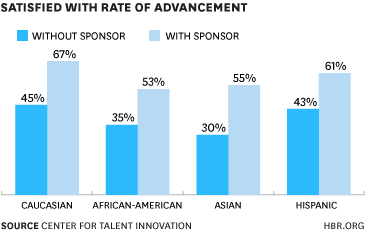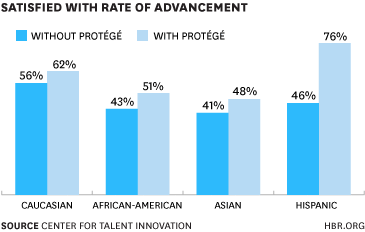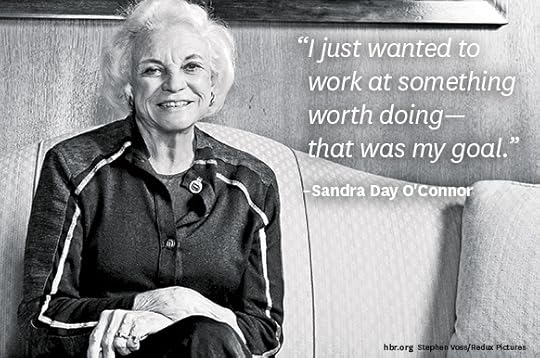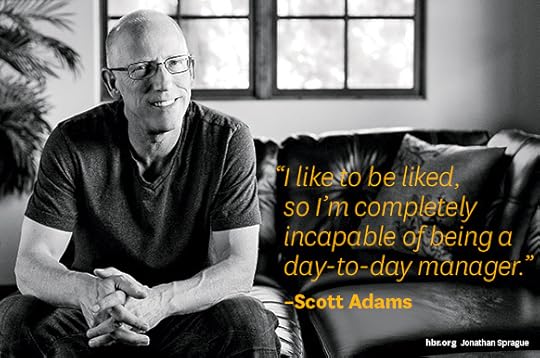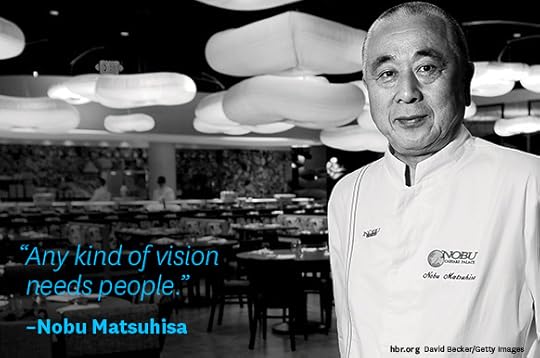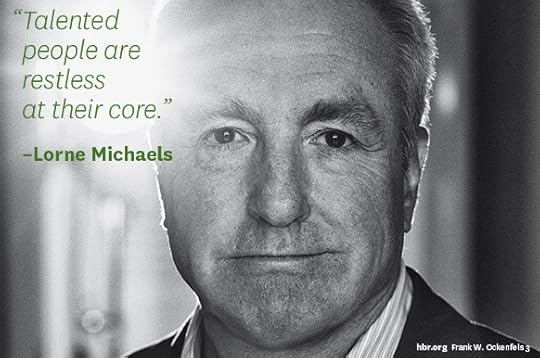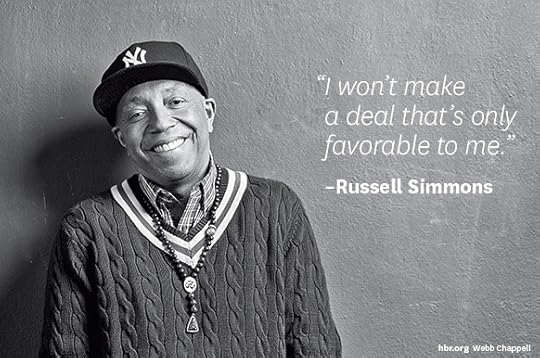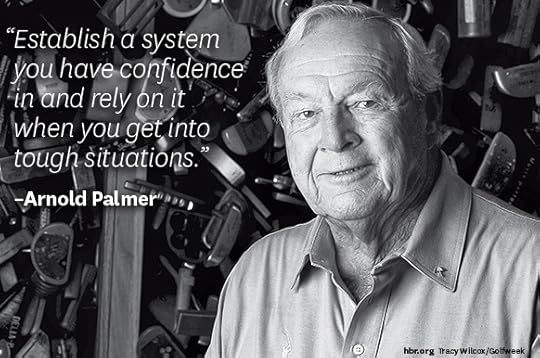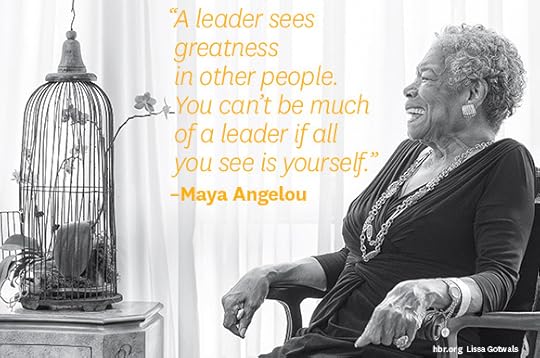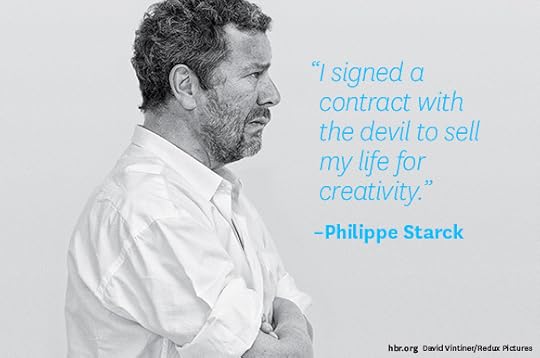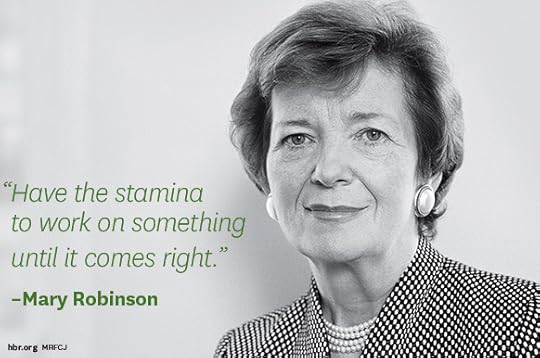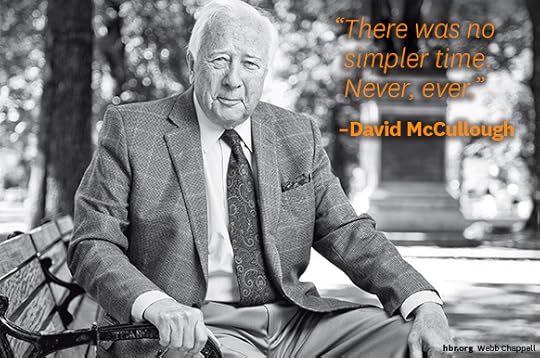Marina Gorbis's Blog, page 1488
January 1, 2014
Achieve Your Goals in 2014 — Here’s Research That Can Help
1. Successful people do nine things differently than everyone else.
2. The rest of us hold ourselves back in five major ways.
3. But don’t stress! Just change the way you think about stress.
4. To spot new opportunities, imagine yourself in the future.
5. And act like a leader before you are one.
6. Decide what not to do in order to make time for the work that matters.
7. Keep meetings on track. Please.
8. Try not to make decisions when you’re nervous.
9. Money can actually buy happiness (if you give it away).
10. Give away your time while you’re at it.
11. Basically, be generous.
12. And say “thank you.”
13. Be quiet (sometimes).
14. Ask for feedback.
15. Pick the right battles to fight at work.
17. Challenge yourself with a growth mindset.
18. Go to sleep.
19. Seriously, go to sleep.
20. And go for a walk, too.
21. Remember: It’s really hard to change.
22. But it can be done.



December 31, 2013
The Key to Making New Year’s Resolutions Stick
This time every year, millions of people across the globe commit themselves to the pursuit of virtuous goals, such as losing weight, being a more understanding boss or partner, obtaining a better education, eating more healthfully, and saving money. But when are such reflection exercises effective? And will your resolutions stick and turn into real changes in your behavior?
Let’s examine each of these two questions. As it turns out, temporal landmarks like the New Year do help motivate us to reach our long-term goals when such goals are salient in our minds. This is because these landmarks trigger reflection and thus can potentially highlight the gap between our current behavior (such as watching TV every night or overspending) and our rosier, desired future behavior (working out every night or saving more). We all regularly face decisions that entail a conflict between choices that primarily provide instant gratification and virtuous ones that mainly provide long-term benefits (watching TV versus working out). As mounting evidence suggests, we often choose what we impulsively want over what we should choose given our long-term goals and interests. (In fact, I wrote an entire book on how we can easily get sidetracked while trying to reach our goals!)
The contrast between our present shortcomings and the hoped-for ideal state that the New Year highlights not only boosts motivation but also helps us meet our goals. For instance, research has found that when individuals who intended to quit smoking wrote about their desired personal future first and then about the negative aspects of their current reality, this contrast was more effective in bringing their actions in line with their expectations than was only fantasizing about future success. Similarly, related research has found that individuals who were committed to the goal of supporting a charity pledged more money when focusing on the discrepancy between the current state (the amount already collected) and the target goal than when focusing on only the amount of money already collected.
It seems that as long as our reflections highlight a contrast between a desired future state and present reality, they should motivate us to act on our goals. Although we can induce such contrasts between current and future goals in many ways (such as by getting feedback from trusted friends and advisors), a temporal landmark such as the start of a new year may be a relatively cheap way to motivate us to accomplish our virtuous goals. Importantly, though, if we feel close to our ideal state already, then the result will be complacency: we will congratulate ourselves for our anticipated achievements rather than take action.
Now, let’s turn to the second question – whether our New Year’s resolutions will actually stick. As it is the case for other points on the calendar that demarcate the passage of time, such as one’s birthday or the start of a new job, the arrival of the New Year generates “fresh start” feelings that can motivate us to meet virtuous goals, such as exercising regularly or finally starting our diet. Psychologically, the New Year gives us an opportunity to wipe the slate clean, and these feelings do inspire beneficial behavior. For instance, a recent study examined gym attendance at the campus of a business school in the Northeastern United States. The results? Gym attendance increased at the start of the year, then decreased over the course of the year.
We certainly do not need to wait until the beginning of the year to get off the couch more often. The start of a month, your birthday, or the start of work after holidays can be equally motivating, this research suggests. Even more interesting, the magnitude of these effects matches or exceeds factors that we would expect to dramatically influence exercise rates. For example, the increase in a person’s probability of going to the gym immediately following her birthday is equivalent to the effect of keeping the gym open for two extra hours.
So, to answer the second question: yes, our resolutions may stick, but our commitment to them may drift over time unless we find regular ways to experience a fresh start.
Many religions have rituals that give people the opportunity to begin anew. In Judaism, at the start of each New Year (called Rosh Hashanah), people reflect upon their bad deeds over the past year and ask for forgiveness, so that they can enter the New Year with a clean slate. Similarly, devout Hindus bathe in India’s holy rivers every year to wash away their sins and get rid of their past imperfections. Whether our reflections are religious in nature or not, their ability to highlight a disconnect between our past behavior and a better future may be worthwhile. However, even without the presence of such rituals, the upcoming transition to a new calendar year can trigger the same sense of dissociation from the past and move us closer to our virtuous goals.



Get Out of Your Comfort Zone: A Guide for the Terrified
No one likes to move beyond his or her comfort zone, but that’s really where the magic happens. It’s where we can grow, learn, and develop in a way that expands our horizons beyond what we thought was possible.
Also, it’s terrifying.
For me, operating beyond my comfort zone was participating in classroom discussions in college. Early in my career, it was public lecturing and participating in departmental meetings. I knew I had things to say, but was very unsure if they were worth saying.
And you know what? I didn’t say a word in nearly all of my undergraduate classes, and uttered very little in professional meetings at for a long time. From talking with others about their own unique fears and challenges, I’m sure I’m not alone.
Fast forward 20 years, and I am now in the interesting position of teaching and coaching others to operate outside their comfort zones. So in this new year, how can we get the courage to take this leap — and develop the skill and ability to actually pull it off?
Tip 1: Recognize When You’re Tricking Yourself
When I was afraid of participating in meetings or in class, I would rationalize away my discomfort. I’d tell myself quite convincingly that, “Participating just isn’t that important.” Now, in my position helping others to operate outside their comfort zones, especially outside of their cultural comfort zones, I hear similar rationalizations: “Networking isn’t that important; it’s the quality of your work,” or “People who network are slimy or full of themselves, and I’m not like that.”
These statements may be true, but they also may be masking the reality of the situation: that you are afraid of networking or public speaking and can’t get yourself to admit it.
So ask yourself this question: If you didn’t experience any anxiety at all in your chosen situation — if it were completely comfortable and stress free — would it be something you’d like to be able to do? Would it be exciting? Would it help your career? If the answer is yes (and be honest!), it’s probably fear that you’re grappling with — and that’s OK. In fact, it’s great to recognize that so you can move onto the next step in the process, which is to use your power of rationalization for instead of against you.
Instead of rationalizing why the behavior is something not worth performing, actively brainstorm all the reasons why it is worth performing. How can taking the leap and starting to work on performing this tough, but key behavior advance your career, give you chances to grow and learn in exciting ways, or whatever other goals you happen to care about?
Answering these questions honestly will actually give you great fodder for moving forward. Understanding why you want to take this leap and what’s in it for you is a wonderful motivator.
Tip 2: Construct a Plan That’s Unique to Your Situation
Taking a leap without a plan is bold, but unwise. And without a strategy for how you are going to actually make this change, you’ll likely end up just where you started. So what kind of strategy should you use?
In my work helping people move outside their comfort zones, I help people clearly and specifically identify what is most challenging for them in a particular situation, and then I provide a set of tools to help them develop a solution for overcoming these particular challenges.
The system I use in scary situations is predicated on the idea that there is no single perfect way to perform the particular behavior you’re working on, be it networking, participating at a meeting, or simply learning to make small talk. Rather, in most situations, you can find a way to customize or personalize your behavior so you are effective in the new situation while not feeling like you’re losing yourself in the process.
Let’s say, for example, that you’re an introvert who simply dreads the idea of schmoozing with a group of strangers at a networking event. In fact, you’d rather skip the event altogether. I know many people in this situation (myself included) and my advice to them — which is similar to the advice Susan Cain gives in her path breaking work empowering introverts to thrive in an extraverted world — is to resist the idea that there is one single way to perform at these events. Yes, for some people it’s natural to do classic, prototypical networking behavior. But for others it’s not. And if that’s you in whatever situation you’re working on, tweak the situation to your liking.
So, in the networking context: instead of feeling pressured to meet everyone in the room, focus on one or two people you seem to hit it off with, and actually try to get to know them. Or, if this type of conversation isn’t for you, especially in a noisy, crowded room, focus instead to making initial contacts at the event with the ultimate goal of arranging follow-up conversations in a more comfortable setting, like over coffee or even on the phone.
The point is that instead of being overwhelmed by the situation, you can take control of it and make it your own. That’s the power of customization.
Tip 3: Find a Mentor or Coach
Even with a solid plan and a revitalized sense of purpose, a good source of help, courage, inspiration, and feedback can seal the deal. It can be a professional coach, but doesn’t have to. A thoughtful and encouraging colleague or friend can also do the trick.
For example, a mentor can help you identify gaps between how you’d naturally and comfortably behave and how you need to behave in the new situation to be effective. A mentor can also then help you customize your behavior to find that sweet spot blending effectiveness and authenticity. Finally, a compassionate and encouraging mentor can help you persevere when the going is tough — and when you’re operating outside your comfort zone, in situations that really matter, that’s almost inevitably going to be the case.
So when it comes to getting outside your comfort zone, don’t mistake magical outcomes for magical processes. Adaptation takes time, effort, strategy, and determination. But with a solid plan in place and the courage to take it forward, your results can be extraordinary.



Which Came First: The Human or the Algorithm?
One thing is for certain: society’s reliance on human judgment, unaided by computers, is going to decrease. This point is made forcefully in a recent post here at Harvard Business Review by MIT’s Andrew McAfee, and in Average Is Over, the latest book by economist Tyler Cowen.
But machine intelligence will not simply displace human intelligence; it is also poised to complement it. In many areas, the combination of human and machine intelligence will outperform either on its own.
How will this collaboration work? Cowen and McAfee both address this, differing on one key dimension: order.
Cowen’s thesis is that one’s ability to augment machine intelligence will define one’s value in the labor market. “Are your skills a complement to the skills of the computer,” he asks, “or is the computer doing better without you?” His key metaphor throughout the book is that of a freestyle chess player. In freestyle chess, human and computer teams play together, and are able to outperform either on their own (at least for now). The key challenge for the freestyle player is not to be a master of chess, but to understand the strengths and weaknesses of chess programs so as to know when to trust their recommendations and when to override them. Here’s how Cowen describes his own amateur experience playing freestyle:
I’ve spent many hours playing a form of Freestyle at home… My procedure is simple. I play Shredder [a chess program for iPad] against itself, but every now and then I overrule the decisions of the program. In essence it’s “me plus Shredder” against Shredder. The human-computer team usually wins. At four or five crucial points during the game, I override the strategic judgment of the program and come up with a better move, or at least what I think is a better move. Then I let the superior execution of the program take over. This works maybe four times out of five.
In this model of human-machine collaboration, the computer handles the bulk of the decision-making, with the human adding a layer of judgment on top. It is echoed in Nate Silver’s book The Signal and the Noise, which uses the rather remarkable example of meteorologists:
The programs that meteorologists use to forecast the weather are quite good, but they are not perfect. Instead, the forecasts you actually see reflect a combination of computer and human judgment… Some of the forecasters [at the National Weather Service] were drawing on these [computer-generated] maps with what appeared to be a light pen, painstakingly adjusting the contours of temperature gradients produced by the computer models… The forecasters know the flaws in the computer models… The unique resource that these forecasters were contributing was their eyesight… According to the agency’s statistics, humans improve the accuracy of precipitation forecasts by about 25 percent over the computer guidance alone, and temperature forecasts by about 10 percent.
But McAfee’s idea of collaboration looks quite different. Here he is responding to experts who claim to consider algorithmic output before making a decision, like the freestyle chess player:
The research is clear: When experts apply their judgment to the output of a data-driven algorithm or mathematical model (in other words, when they second-guess it), they generally do worse than the algorithm alone would. As sociologist Chris Snijders puts it, “What you usually see is [that] the judgment of the aided experts is somewhere in between the model and the unaided expert. So the experts get better if you give them the model. But still the model by itself performs better.”
Things get a lot better when we flip this sequence around and have the expert provide input to the model, instead of vice versa. When experts’ subjective opinions are quantified and added to an algorithm, its quality usually goes up. So pathologists’ estimates of how advanced a cancer is could be included as an input to the image-analysis software, the forecasts of legal scholars about how the Supremes will vote on an upcoming case will improve the model’s predictive ability, and so on. As Ian Ayres puts it in his great book Supercrunchers, “Instead of having the statistics as a servant to expert choice, the expert becomes a servant of the statistical machine.”
This idea isn’t new — it fits within a long literature about information aggregation that doubles as the intellectual justification for crowdsourcing. As law professor Cass Sunstein summarized in his 2006 book Infotopia:
Suppose that we want to answer a disputed question of fact… A great deal of evidence suggests that under certain conditions, a promising way to answer such questions is this: Ask a large number of people and take the average of the answer… When the relevant conditions are met, the average answer, which we might describe as the group’s “statistical answer,” is often accurate, where accuracy is measured by reference to objectively demonstrable facts.
What is averaging, after all, but an extremely simple algorithm?
These two models for human-machine collaboration raise a number of questions, including which will be more effective, and whether human judgment will be valued more in the market when the human is feeding the algorithm or when the human is overriding it.
Some of the most interesting research on these questions is being done by Philip Tetlock of Wharton, who is running a series of geopolitical forecasting tournaments and measuring how well teams of experts do at prediction, compared to algorithms based on those same experts’ analysis. Here’s how he described this work at Edge.org in 2012:
In our tournament, we’ve skimmed off the very best forecasters in the first year, the top two percent. We call them “super forecasters.” They’re working together in five teams of 12 each and they’re doing very impressive work. We’re experimentally manipulating their access to the algorithms as well. They get to see what the algorithms look like, as well as their own predictions. The question is–do they do better when they know what the algorithms are or do they do worse?
Ultimately, the debate over which model of collaboration is most effective is likely to become as circular as the one over the chicken and the egg; algorithms will feed humans who will feed algorithms who will feed humans and so on. Decision-making is, after all, a multi-layered process.
The controversy will be over who gets final say, the human or the algorithm. Philosophically, this may seem a moot point for now, so long as humans control computers. Even if we “let” the algorithm have the final say, we’re the ones making that decision. Still, this final layer of decision making will be contentious in practice. Imagine the case of a medical diagnosis. A doctor consults the advice of an algorithm which uses your health records to remind her of the most statistically likely ailments. She then questions you and submits her observations and her best diagnosis to yet another algorithm which issues your “final” diagnosis. If the doctor has a nagging suspicion that the algorithm’s diagnosis is wrong — one that she can’t explain except with reference to her intuition and experience — whose diagnosis do you act on?
Different answers to this dilemma will be appropriate for different sectors, based on both efficacy and what we’re able to stomach. Determining which approach works when will require plenty of research and a good bit of trial and error.
Nonetheless, combined human and machine intelligence, in one form or another, will likely define much of our work lives. Unless, of course, we put it off long enough that computers start making decisions without our help at all.



The Three Most Innovative Companies of 2013
One can naturally debate any system that seeks to crown the world’s most innovative companies. Boston Consulting Group’s list, which relies heavily on surveys asking senior executives to name the companies they perceive to be innovative, risks succumbing to the halo effect, where generally successful companies are assumed to be good at everything. Forbes’s mathematical approach, which calculates an “Innovation Premium” baked into a stock price, suffers from market capriciousness. Editorial driven approaches at MIT Technology Review and Fast Company can trip over hype (recall how Fast Company in 2009 named “Team Obama” its most innovative company?).
Nonetheless, if you want a fun ice-breaker at your next team meeting, ask people to guess which three companies made it to the top 50 on all four lists (only 29 made it on two or more, and only seven are on three or more). You can even give a hint – two of the three are technology companies from America’s West coast, and one is from Asia.
If your groups are anything like the ones I’ve been with over the past few months, they will assume that the American companies are some combination of Google, Apple, and Amazon. Apple is perhaps the surprising odd man out of that troika, ranking 79th in Forbes’s list (owing primarily to a somewhat bumpy stock price, which to Forbes indicates a lack of investor confidence in its ability to innovate in the future).
But if you’d guessed Google and Amazon, you’d be right. Both trace their success to bringing new business models to their respective markets. While Google is commonly viewed as a search company, what made Google Google was figuring out how to parlay its search technology into a highly disruptive advertising model by which companies bid to tie their advertising to specific search terms. In recent years the company’s free, flexible Android operating system – a stark contrast to the closed, proprietary systems that historically dominated the industry – has helped new competitors like Samsung from South Korea and ZTE from China offer devices that are both low priced and highly functional.
Amazon continues to be the world’s best example of a serial business model innovator. Its core e-retailing model, with its hyper-efficient supply chain, turned the retail world on its head. It has subsequently launched three successive disruptive business models. Its Prime subscription model now provides close to $1 billion of revenues. With its Kindle e-reading platform, the company happily sells low-cost devices and makes money on content. And through its Amazon Web Services business, it has built a multibillion-dollar business by turning its internal technology prowess into a powerful cloud-computing service.
So, which is the third company on all four lists? Some guess Korea’s Samsung (on three); Japan’s Toyota (on two); China’s Huawei (interestingly, on none of the lists); or Alibaba (also, shockingly, on not a single list). The home country of the latter pair is right, but the right company is Tencent.
Tencent remains relatively unknown outside Asia, but that won’t last long if its torrid growth continues. Its core offerings — its QQ instant-messaging service and WeChat SMS service — aren’t particularly interesting. But it follows a business model that is distinct from most of its competitors. Instead of seeking to build wide audiences and parlaying them into advertising revenue, the company has built a multibillion-dollar business out of micro-transactions, such as charging consumers to upgrade the look of the avatar that appears on their chat service. Hundreds of millions of small transactions add up, powering the company’s explosive growth. A chart in a recent Economist article says it all. Global Internet giants like Baidu, Google, and Facebook each draw at least 80% of their revenues from advertising. Tencent has flipped the model, earning about 80% of its $7 billion annual revenues from value-added services.
Innosight research shows that business model innovation is the ticket to explosive growth. In Seizing the White Space, my colleague Mark Johnson noted that more than half of the relatively recent companies that made it onto the Fortune 500 before their 25th birthday—including Amazon, Starbucks, and AutoNation—were business model innovators. It’s easy to get captivated by shiny technology or compelling marketing, but if you really want to identify tomorrow’s giants, pay the most attention to innovators that have figured out how to create, capture, or deliver value in unique ways. History shows they are the best bets for long-term success.



Inflation-Adjusted Median Earnings for Male U.S. Grads Have Fallen Over Past 40 Years
For young American men with at least a bachelor’s degree, median earnings were significantly lower in 2011 than in 1971, if inflation is taken into account. Moreover, the real average earnings of college graduates ages 25 to 34 with just a bachelor’s degree have declined about 15% since 2000, says Nancy Folbre of the University of Massachusetts. Nevertheless, a college education still gives young adults an earnings boost that is more than enough to justify its cost, Folbre says.



December 30, 2013
Why I Put My Company on a Year-Long Sabbatical
Last year, I placed my entire communications agency, Global Tolerance, on a year’s sabbatical. On the surface, it seemed like a crazy decision. I’d spent the past decade building the company from scratch, hiring a talented team, winning high-profile clients, from TED and The Gallup Organization to His Holiness the Dalai Lama and Gandhi’s grandson, and increasing revenues every year. Why would I put all that on hold?
The answer is simple: So we could come back even better.
The very idea of a sabbatical, a rest from work, comes from the biblical sabbath, and a commandment to stop working the fields every seven years. This is so Mother Nature can renew the fields and help ensure the possibility of future harvests. Businesses have long reaped rewards from biomimicry, the imitation of natural systems to solve human problems. If the flight of pigeons can inspire the first aircraft; termites can provide lessons for energy-efficient buildings; and butterfly wings can influence next-generation phone displays, why shouldn’t we cultivate the idea of fallow fields for our office lives?
For many years, Global Tolerance had been enjoying a daily 60-second sabbatical through a simple daily ritual. Weekdays at 530pm, I would ask the team to share a minute of silence around a powerful question, such as “What does it really mean to grow?” or “What’s your favorite childhood memory?” We called it “the sound of silence,” and the results were extraordinary. The exercise left the team feeling deeply connected, to themselves and each other, and led to creative ideas for clients.
So how did I move from 60 seconds a day to a full year of everyone’s lives?
On a personal level, my frenetic work building the company was beginning to take a toll at home. I was unwittingly neglecting my wife, my family, my friends, and myself as well. In October of 2010, I became sick, bed-ridden for two months. But still I ploughed on.
On an organizational level, even though we were growing, we seemed to be constantly juggling the increasing demands for client work and the commercial realities of cash flow. We needed a radical, reflective look at the mission and business of Global Tolerance, and this could only be done by taking some serious time out.
I also realized there was precedent. Glastonbury, one of the biggest music festivals in the world, regularly skips a year for the same reasons they did in biblical times. The English fields on which it’s held need time to be restored, and anticipation for the festival’s return is greater than ever. As Michael Eavis, the founder of the festival, says about the sabbatical: “It’s a rest for the countryside, for the kingfishers on the river, the owls in the oak trees. They too get a breather. And the fallow year was the best thing I ever did. It gives value to our integrity.” Stefan Sagmeister places his New York design agency one a one-year break every seven years as well. He’s designed space for rest and reflection into his business model, and the creative ideas that emerge from that year feed the next long period of work.
Suddenly, the relentless pursuit of revenue, profits and impact at the expense of personal health, wellbeing and relationships seemed to be the crazy approach. So I decided Global Tolerance should take the plunge.
Logistically, this wasn’t easy. Our HR people said there was no such thing as a company sabbatical. It had never been done before. People would need to resign, or sacked. I ignored HR and trusted in the integrity of my team and our shared ability to come up with a solution that worked for everyone. I made sure to start the conversation early. We had numerous discussions, individually and collectively, to work out what the sabbatical would look like, and what it would mean for each person. The conventional wisdom in this situation would be to ensure our clients wouldn’t be taken, but I decided to turn this on its head. In fact, for a couple of staff, I negotiated ways in which they could set up as freelancers and take our clients with them. The clients appreciated not being left in the lurch. The team members were happy as they got to earn more money working less hours, while also learning the leadership skills that come with running one’s own business.
We’re all trained to be ambitious. We want to grow, win, succeed–and it feels wrong to stop, even for a moment. But what does it really mean to grow? To win? To succeed? Global Tolerance might not be racking up profits this year, but as I sit here with my baby daughter giggling in the room next door, I can safely say this has been my greatest year of growth. Colleagues report similar experiences. Some are focusing on former passions; others are trying new experiences.
I realize that for most people, it’s simply not practical to take a sabbatical. But as we learned in our “sound of silence” exercise, even 60 seconds of quiet time can help. Better yet, take a day or a week. If you’re a manager, allow your employees to do so. And if you’re a corporate leader, consider institutionalizing a sabbatical system as a means of supporting your workers. When we do stop, and give ourselves time to listen to our bodies, and learn from the patient pace of nature, then our growth and success are imbued with new meaning.



Five New Year’s Resolutions Every Leader Should Make
Looking ahead to 2014, one of the most urgent issues will be a new war for talent: not yesteryear’s broad-based need for all top talent but an increasing demand for the right kind of talent. For leaders, this means a new urgency in targeting, nurturing, and advancing top talent in their organization. Leaders have long recognized that an inherently diverse workforce – one that’s inclusive of women, people of color, and gay individuals – confers a competitive edge in selling products and services to diverse end users. But recent research from the Center for Talent Innovation (PDF) shows that an inherently diverse workforce can be a potent source of innovation, as diverse individuals are better attuned to the unmet needs of consumers or clients like themselves. How can leaders leverage and develop diverse talent in 2014? CTI research spotlights five ways:
1. Be more inclusive. What does it take to consistently drive growth and innovation? The answer, according to CTI’s latest research, is a diverse workforce managed by leaders who cherish difference, embrace disruption, and foster a speak-up culture. Leaders have long recognized that an inherently diverse workforce “matches the market” and confers a competitive edge by recognizing the unmet needs of consumers and clients like themselves. But ideas from outliers too often are ignored or squelched because their originators don’t resemble the paradigms of corporate power — Caucasian, male, heterosexual, and from a similar educational and socioeconomic background.Leaders who promote a culture of diverse talent — whether in their team or throughout their organization — where everyone feels free to volunteer opinions or propose solutions that contradict convention unlock the full spectrum of innovative capacity.
2. Create pathways for sponsorship. What can help talented women, gays, and people of color spread their wings and succeed? The answer is sponsorship — a strategic workplace partnership between those with power and those with potential. Unlike mentors, who act as sympathetic sounding boards, sponsors are people in positions of power who work on their protégé’s behalf to clear obstacles, foster connections, assign higher-profile work to ease the move up the ranks, and provide aircover and support in case of stumbles. Sponsors have a significant impact on the career traction of their female and multicultural protégés: 68% of women with sponsors say they are satisfied with their rate of advancement, compared with 57% of those without sponsors; 53% of sponsored African-Americans and 55% of Asians are satisfied with their career progress, compared with, respectively, 35% and 30%. Those numbers add up to employees who are more committed, more engaged, and more likely to attract similar talent.
Why take on the responsibility — and risk — of becoming a sponsor? By building a dedicated team of talent, sponsors see a measurable benefit to their own careers: White leaders — both men and women — with a posse of protégés are 11% more satisfied with their own rate of advancement than those who haven’t invested in up-and-comers. Sponsors of color who have developed young talent are overall 30% more satisfied with their career progress than those who haven’t built that base of support.
3. Crack the code of executive presence. Performance, hard work, and sponsors get top talent recognized and promoted, but “leadership potential” isn’t enough to lever men and women into the executive suite. Leadership roles are given to those who also look and act the part, who manifest “executive presence” (EP). According to CTI research, EP constitutes 26% of what senior leaders say it takes to get the next promotion. EP rests on three pillars: gravitas (the core characteristic, according to 67% of the 268 senior executives surveyed), communication skills (according to 28%), and appearance (the filter through which communication skills and gravitas become more apparent). Yet because senior leaders are overwhelmingly Caucasian and male, women and multicultural professionals find themselves at an immediate disadvantage in trying to look, sound, and act like a leader — and they’re not getting the guidance they need to acquire it.
Across the board, 56% of minority professionals feel they are held to a stricter code of EP than their Caucasian peers. Further, the research found that EP feedback is either absent, overly vague or contradictory: More than three-quarters (79%) of people of color surveyed say that when they get feedback, they are unclear how to act on it, with Asians (84%) and Hispanics (80%) particularly confused about how to course-correct. As a way to endow their protégés with even more power, leaders can resolve to give more — and clearer — feedback in 2014 to help their reports understand, acquire, and eventually ace EP.
4. Be a more active ally. Despite advances in workplace acceptance, 41% of American lesbian, gay, bisexual, and transgender (LGBT) workers remain closeted at the office in 2012. Given the increased productivity and lower turnover rates of “out” workers , companies have a bottom-line incentive to create a workplace where LGBT workers feel accepted, valued, and comfortable being who they are. What makes work a place where LGBT talent can thrive? Allies — people who support or work as LGBT advocates — play a decisive role in creating an open community where individuals are comfortable being themselves. CTI research finds that 24% of LGBT workers attribute their decision to come out professionally to a strong network of allies. Although the ally phenomenon is widespread and growing (70% of men and 83% of women consider themselves allies), only 8% of men and 19% of women qualify as “active allies.”
Closeted LGBT employees are 73% more likely than their out peers to say they intend to jump ship within the next three years. However, with leaders who are active allies, that is, those who openly support LGBT colleagues at work, LGBT high-performers are far more likely to stay.
5. Be a more proactive protégé. The dynamics — and the rewards — of the sponsor–protégé relationship don’t end with a big promotion; they last throughout a career. Think about it: CEOs need people they can rely on as the go-to person for high-profile trouble-shooting, as the perfect candidate to lead those massive projects that can make or break a company’s future, as the reliable source for innovative solutions. At the same time, sponsorship can never be taken for granted. In today’s uncertain economy, executive teams can get reshuffled without notice, leaving you without protection.
Resolve to tend that reciprocal relationship with your existing sponsors — and extend your network of new sponsors— in the new year. According to CTI research, the vast majority of white-collar employees in the United States work for companies that fail to realize their full innovative potential because their leadership lacks the inclusive behaviors needed to effectively “unlock” the innovative potential of an inherently diverse workforce. Leaders who resolve to inculcate behaviors and disseminate practices that endorse, encourage and empower women, people of color, and LGBTs are far more likely both to retain a broader spectrum of top talent as well as tap into an ever-replenishing well of innovation.
Talent and the New World of Hiring An HBR Insight Center

Make Sure Your Dream Company Can Find You
Never Say Goodbye to a Great Employee
What Boards Can Do About Brain Drain
How an Auction Can Identify Your Best Talent



Business Resilience Comes from Working with Nature
Hurricane Sandy, the superstorm that pummeled the U.S. northeast in October 2012, ranks as the second-costliest hurricane in American history, causing an estimated $68 billion in damages. One year later, the most powerful storm ever recorded to hit land devastated the Philippines.
With these once extraordinary events becoming more ordinary, it’s becoming clearer that businesses in vulnerable regions need to prepare. But how should companies go about building resilient enterprises that are ready to face extreme weather and other effects of climate change? One powerful, underleveraged option is to use nature to protect our coasts and physical assets — that is, to invest in so-called “green infrastructure” a term meant to differentiate projects from more typical “gray” or man-made infrastructure solutions (such as dams, levees, and water treatment systems) that we build to cool and purify water or defend our buildings and assets against the elements.
Our natural world already provides immensely valuable services to make our economy and society possible. Most obviously, we get all our food, minerals, and metals from the ground, and forests provide wood and oxygen. But there are more subtle benefits: forests also clean our water and coastal wetlands and reefs provide natural defense from storms and floods. They can help us manage rainwater and wastewater. These services, which are not currently valued in the marketplace, protect both people and commercial and residential assets.
So a city or company looking to safeguard its water supply, for example, could invest in protecting or restoring lands instead of building a new water treatment plant (which is exactly what the New York City did when it bought land in the Catskill Mountains in 1997 — this initiative avoided up to $8 billion in costs for a new filtration facility and saved $200-$300 million in ongoing operation and maintenance costs).
But is this kind of green infrastructure approach generally as effective? Is it cost competitive? A recent paper by Shell, Dow, Swiss Re, Unilever and The Nature Conservancy concludes that frequently, it is.
Using standard cost-benefit analysis, the study compared some natural solutions to more traditional infrastructure investments. In all of the completed corporate projects, the green option won out toe-to-toe on capital expenditures and operational expenditures
Here’s one of the more compelling examples highlighted in the paper:
One of Shell’s joint ventures, Petroleum Development Oman LLC (PDO), uses constructed wetlands to treat produced water from oilfields. PDO’s extraction activities produce a lot of oily water as a by-product. After investigating alternative, low cost solutions to treat and dispose of the water, PDO built a natural wetland system that uses sunlight, reeds, and gravity (to flow water down in steps) in place of extensive water treatment and injection operations. The latter, gray option would have required significant electric power and produced high greenhouse gas emissions… and it would’ve cost a lot more.
On every important measure — capital expenditure, operational expenditure, and performance — the constructed wetland outperformed the traditional approach. Power consumption and CO2 emissions were reduced by 98%, which lowered operating expenses dramatically. And as a bonus, the wetland provides habitat for fish and hundreds of species of migratory birds.
In this particular case, PDO only needed the natural option, but the study concluded that hybrid solutions – combinations of green and gray infrastructure — may often provide the best mix of benefits. Together, green and gray solutions combine some of the resilience inherent in natural systems with the way an engineered solution can solve a specific challenge.
Shell isn’t the only company that discovered the savings from green infrastructure. The report includes case studies for Dow, which also utilized a constructed wetland at one of its facilities, reducing capex expense by a factor of 10. Today, Dow is exploring additional applications of green infrastructure and is engaged in a multi-year collaboration with The Nature Conservancy on valuing ecosystem services, which includes evaluating the viability of natural infrastructure at its largest production site.
Companies with common challenges can identify savvy, shared investments in green solutions for wastewater treatment, desalination, or coastal defense (using, say, wetland and reef restoration) and potentially collaborate on new green infrastructure opportunities at co-located assets.
Collectively, the companies in the report concluded that green infrastructure solutions should become a major part of the modern engineer’s standard toolkit: “Incorporating nature into man-made infrastructure can improve business resilience —and bring additional economic, environmental and socio-political benefits.” The report also provides an emerging set of performance metrics that managers can use to assess and compare green and grey infrastructure options.
As the damages from (and costs of) extreme weather and other disruptions soar, investing in resilience becomes a better deal. And nature can provide many of the solutions we need to both save money and protect our assets. So run the numbers on green infrastructure solutions. The calculations are likely to show that green options are the best investments.



10 Extraordinary People and Their Lessons for Success
From presidents to hip-hop producers to poets, the last page of every issue of Harvard Business Review is always an interview with someone who has succeeded outside the traditional corporate world. Here, some of our favorite lessons from the class of 2013:
Justice Sandra Day O’Connor on having long-term colleagues: “Treat people well. Don’t mislead them. Don’t be prickly. Don’t say things that are aggravating. Try to be as agreeable as you can be. Try to be helpful rather than harmful. Try to cooperate.”
Cartoonist Scott Adams on using his MBA: ”When the comic strip first came out, it showed Dilbert in a variety of settings—not just the office. I didn’t really know what was working, because I had no direct contact with readers… So way back at the dawn of the internet, I started putting my e-mail address in the margin of the strip… I found out that there was a common theme: People loved it when Dilbert was in the office, and they liked it a lot less when he was at home or just hanging around. So Dilbert became an office-based comic, and that change made it all work.”
Chef Nobu Matsuhisa on starting as an apprentice: “I was 18 and didn’t know anything about fish. My mentor taught me the basics. For the first three years, I didn’t make sushi; I washed dishes and cleaned the fish. But if I asked questions, he always answered. I learned a lot of patience.”
Saturday Night Live producer Lorne Michaels on hiring: “I wouldn’t choose anyone whose side I didn’t want to be on. It isn’t like we hire 12 and figure six will work. We don’t bring in anybody we’re not rooting for. Sometimes they succeed in week five, but for most people it’s two, three, four years before they become who they’re going to be. You have to allow for that growth.”
Hip-hop mogul Russell Simmons on meditating twice a day: “Every creative idea, every second of happiness, is from stillness…. But the way you move around the world has nothing to do with the stillness in your heart. Moving meditation—that’s what we have to practice. It doesn’t mean you have to move slow; you just have to see the world in slow motion.”
Golfer Arnold Palmer on learning humility: “One time at Augusta, I was going into the last hole with a one-shot lead to win the Masters, and a friend from the gallery hollered at me, so I walked over and accepted congratulations. And then I proceeded to make six on the hole and lose. My father had warned me about that. I was told all my life not to accept congratulations until it’s over.”
Poet Maya Angelou on courage: “One isn’t born with courage. One develops it by doing small courageous things—in the way that if one sets out to pick up a 100-pound bag of rice, one would be advised to start with a five-pound bag, then 10 pounds, then 20 pounds, and so forth, until one builds up enough muscle to lift the 100-pound bag. It’s the same way with courage. You do small courageous things that require some mental and spiritual exertion.”
Designer Philippe Starck on persuading clients: “I’m very good at explaining. I don’t work like a diva. I don’t say, “Oh my God, that must be pink,” and refuse to discuss it… I am cuckoo, yes. I am the king of intuition. But I am also a serious guy. I explain in a clear way. And then, even if it’s something that looks completely different than expected, something completely against mainstream thinking, clients understand. I explain that it might look strange but why, given the two to five years it will take for development, it will for so many reasons be exactly the right thing to do… And then the clients agree, always, 100%.”
President Mary Robinson on being frank: “At every stage, it’s [a] passion for human rights that has prompted me to speak truth to power, to stand up to bullies, to be prepared to criticize even the United States after 9/11. People told me it wouldn’t help my career as high commissioner, but it seemed much more important to do the job than to try to keep the job.”
Historian David McCullough on hard work: “When the founders wrote about life, liberty, and the pursuit of happiness, they didn’t mean longer vacations and more comfortable hammocks. They meant the pursuit of learning. The love of learning. The pursuit of improvement and excellence. I keep telling students, ‘Find work you love. Don’t concern yourself overly about how much money is involved or whether you’re ever going to be famous.’ …In hard work is happiness.”



Marina Gorbis's Blog
- Marina Gorbis's profile
- 3 followers


